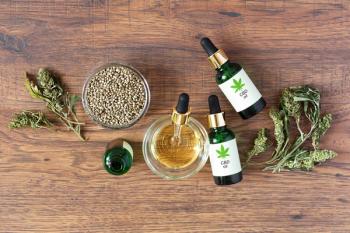
- March/April 2021
- Volume 2
- Issue 1
One Nurse’s Battle with the Stigma Against Medical Cannabis Use and Chronic Pain
Eloise Theisen, a board certified Adult Geriatric Nurse Practitioner who specializes in cannabis therapy, shares her unique insight from helping patients.
An interview with Eloise Theisen, a board certified Adult Geriatric Nurse Practitioner who specializes in cannabis therapy and the president of the American Cannabis Nurses Association.
Chronic pain has been described as an “unpleasant sense of discomfort” (1), which may persist or continue to progress over an extended period of time. In the case of acute pain, it arises rather quickly as a result of a bodily response to an injury and is often treatable. With chronic pain, the discomfort is typically resistant to medical treatments. Medical conditions such as fibromyalgia, cancer, shingles, arthritis, diabetes, previous injuries, and so forth are among the many ailments that can be connected to chronic pain. Environmental or psychological factors have also been found to aggravate and worsen chronic pain.
Eloise Theisen, an Adult Geriatric Primary Care Board-certified nurse practitioner, who has been in the nursing field for more than 21 years is now using her medical expertise to assist patients in using medical cannabis to treat their chronic pain. Aside from Theisen’s medical experience she is also the Chief Nursing Officer at Leaf411, which is a free cannabis hotline for anyone who wants to call and discuss their cannabis use or inquire about cannabis use with a nurse (2). Theisen is also the president of the American Cannabis Nurses Association (3). Originally, Theisen began her impressive nursing career in oncology. In this department, it was quite common to see patients experiencing chronic pain issues from the illness or cancer treatments. When she first began seeing patients using cannabis, she didn't have much of a curiosity to explore it further. However, seven years ago she saw an increase in patients interested in using the medicinal plant as part of their cancer care treatment plan and decided to use the knowledge she gained from her personal experience with cannabis to help patients. Thus began her journey into the medical cannabis landscape.
"It became really clear to me that most healthcare professionals did not have good knowledge of cannabis and how to help patients access it safely and effectively," said Theisen. "Because of my personal experience, I decided to create a practice designed to help patients navigate cannabis as a medicine.”
Cancer patients suffer from treatment side effects such as chemotherapy-induced peripheral neuropathy or severe bone pain related to their cancer diagnosis. Through the help of the internet, patients were doing their own research to find alternatives to alleviate or manage their symptoms. Theisen mentioned that patients were also turning to her for guidance. “I started to really help these patients answer questions, help them determine how to find a safe product," she said. "This was prior to legalization in California. We didn’t have good regulations in place around testing.”
Before the legalization of cannabis in California, there weren’t quality control (QC) or quality assurance (QA) regulation standards to ensure that customers were being offered a safe product. “Products could be sold to patients and they could have high levels of molds or bacteria in them,” said Theisen.
Conventional treatment options have started to lose some of their appeal to those suffering from chronic pain conditions. More and more patients have been seeking out medical cannabis to treat their conditions rather than use traditional methods. Over the past seven years, Theisen has witnessed a lot of chronic pain patients who were on treatment plans containing medications such as opioids to manage their pain, become ineffective or have extreme side effects that greatly diminish their quality of life. Cancer patients were being told to reduce their opioid prescriptions due to the growing epidemic of overdoses and addiction. With these reductions, patients weren’t being offered any alternatives to help ease their discomfort. Being in pain, this was spurring the uptake in patients looking into medical cannabis as a treatment option. “When my patients come to me for cannabis, for chronic pain, many of them are looking to also reduce their pharmaceutical intake," Theisen explained. "I see them improving their symptom management and also reducing their overall pharmaceutical burden.”
By helping patients switch over to the medicinal plant, Theisen was seeing their quality of life and medical conditions improve.
Medical Cannabis Challenges: Stigma, Dosing, and More
Due to the stigma surrounding cannabis, there are still patients who are hesitant to try it. Often, these kinds of patients have gone through conventional treatment plans and are at their last resort for seeking relief. Theisen said that there is still a part of them that carries the stigma of pot heads or stoners. “Most of my patients are older adults, so their average age is around 76. They were the generation that really did tell their kids to say no to drugs. They generally had harsh consequences if they found their kids were consuming drugs, particularly marijuana. They really struggle with allowing themselves to try it because they feel guilty about all these years that they demonized cannabis and now they’re trying to come to it for their own condition management, symptom management," said Theisen. "It’s often their grandkids that are trying to encourage them to use it, to look at it differently. It can definitely inhibit their ability to really explore the plant. That stigma can carry over in ways. For example, they may try it and they don’t get results right away. They just say, see, I knew it and then they give up.”
For new patients, Theisen goes through their health history and inquires if they’ve used cannabis in the past such as in high school or college and if so how they reacted to the plant, negatively or positively. Particularly, most negative experiences she heard were from edibles containing tetrahydrocannabinol (THC). Most patients who come to Theisen though, haven’t tried cannabis prior to seeing her. Occasionally, there are also patients who come in and are reluctant to use cannabis due to little information on medication reactions with the plant. When this situation occurs, Theisen describes the experiences she has had with the more than 6500 patients she has treated. She also monitors her patients regularly and follows them along their medical cannabis journey. By providing that extra layer of calm, this helps give her patients a little bit more confidence in their treatment plan. “There are times though where people are taking certain things and I’m like we have to limit your use because there is a potential for drug-drug interaction," said Theisen. "One example is immunotherapy and THC. In the cancer population, we do have patients who want to use high doses of cannabinoids to treat their cancer. Again, this is sort of the internet’s version of what cures cancer. We do have some animal data to demonstrate that the cannabinoids can play a role in cancer treatment. But there’s been some small studies demonstrating that if you’re using high amounts of THC with immunotherapy, that it can decrease your response rate to that immunotherapy treatment.”
She also mentioned that using these products didn’t affect the overall survival rate, but that there are times when the amount or dosage could have an affect on their other treatments. It is very important to educate patients on the proper dosing of cannabis so they can better understand that the plant also has bidirectional effects. Theisen explained that by starting patients out on a lower dose and slowly increasing that dose, it helps avoid negative side effects and also aids in them finding their therapeutic window so that they are not over-consuming and are getting the best benefit with the least amount of side effects.
As we age, our ability to process medications decreases by around 30%. This may begin happening in our 40s and 50s. Theisen started recognizing that standard dosages being provided in dispensaries were inappropriate for her most common clientele—the older adult. “I really started to look into reducing those. Again, there is no real standard out there for cannabis dosing. The studies that we have with some dosing comes from either Sativex—that one-to-one tincture out of the United Kingdom—or Dronabinol, which is a synthetic THC, Food and Drug Administration (FDA) approved medication," she said.
Theisen explained that her dosing recommendations have changed over time. "I’ve evolved with THC and cannabidiol (CBD). I’ve gathered information around gender differences. There are definitely different protocols based on your gender and your age," she said. "We’ve also been really fortunate to have an evolution of cannabinoids available to us like cannabigerol (CBG), delta-8-THC, tetrahydrocannabinolic acid (THCA), and cannabidiolic acid (CBDA). The more information that comes out, the more the dosing regimen evolves and changes.”
Lack of Support from Medical Professionals and Insurances
With the legalization of cannabis growing in the United States, you would think that medical professionals would become more open to prescribing medical cannabis to their patients. Theisen has been witnessing a shift in the healthcare field, but still sees a majority of healthcare professionals as not being fully on board with the medicinal plant. They will often mention that there’s not enough research to support this method for treatment. Theisen believes that there is still a lot of fear and stigma among healthcare professionals because of its Schedule 1 ruling and status (4). “Often I hear from other healthcare professionals that they don’t want to discuss it or even learn about it because of that schedule and status. It does prohibit them from exploring it. I’ve seen more nurses and nurse practitioners’ sort of lead the change and get educated, which is not surprising,” Theisen said. Nurses have a boots on the ground mindset and are usually with patients the most. Physicians typically say that if they want to use cannabis that is fine, but that they cannot prescribe it which leaves patients without the proper resources to safely and effectively access this plant medicine.
When patients come to Theisen for their chronic pain, they already have it in their minds as to what type of regimen they want and that usually involves CBD. They do not want to smoke it and they do not want to get high from it. What Theisen and other medical professionals have found is that THC may also play a vital role in their treatment. “We find that a lot of the research that does come out around Sativex for chronic pain does demonstrate that THC is a very important part of that regimen also, especially if they’re coming off some of their opioids or other pain medications, the THC can really help with the withdrawals," said Theisen. "Their protocol might change from the time they begin to the time that they come off their medications. If that’s their choice. It evolves during that. I think cannabis is best when it is personalized. We can certainly have best practices around it, such as stating which is the right cannabinoid for a certain condition and a good starting dose. But the more we personalize it, the better outcome we’ll see.”
In order for a patient to begin their medical cannabis journey, Theisen is very thorough on going through their health history to see what they have tried in the past, what worked, what didn’t work, what helped their condition, what made their condition worse, medications they may currently be taking, and so much more. Drinking alcohol, water intake, and diet are also factors that play a role in regulating your endocannabinoid system (ECS), which is important to detail because the ECS is where cannabinoid receptors are located and play a role in how the body processes the cannabinoids found in cannabis (5). Theisen also likes to have this information aside from the benefit of the ECS, because as great as cannabis can be, it isn’t a silver bullet or cure-all treatment. There are often multiple factors needed to help manage chronic pain.
Unfortunately, insurance companies and the government do not offer financial assistance plans or discounts to medical cannabis users because of its scheduling. For patients who are beginning to research their treatment options with Theisen, all hope is not lost. Her patients are able to get reimbursed for their visits if they have a health savings account (HSA). This may be an option a patient can use with other healthcare professionals involved with cannabis. Theisen remained hopeful that this may be an area in the healthcare industry that changes in the future. For a patient to have everything be out of pocket, it definitely puts a financial strain on them. Cannabis has a stigma around it, which makes insurance companies uncomfortable to cover it. Theisen stated that it should be a patients choice to use their coverage for what they feel is best for their chronic pain, whether that is medical cannabis or opioids. Insurance companies still view the medicinal plant as a drug of abuse, though this plant has various therapeutic properties and should be viewed as a means to provide a patient with a higher quality of life.
Cannabis Resources for Patients and Healthcare Professionals
Aside from meeting with chronic pain patients, Theisen is also the cofounder and chief executive officer (CEO) of Radicle Health (6), which is an education and training company that she cofounded with Timothy Byars. Radicle’s mission is to educate healthcare professionals on the benefits of medical cannabis for various health conditions. Theisen explained that the lack of education out there is by far one of the biggest gaps in the industry at this moment. Without the education, consumers also aren’t educated. There is a lot of misinformation spreading as well. Radicle uses evidence-based research and compiles it into different levels of education that can be purchased by a healthcare professional or the consumer but is geared more heavily in the science category. Theisen mentioned that their goal is to standardize education and training so that patients, consumers, healthcare professionals, and the general public as well as policy holders are all provided with the same information to try and bring change to the stigma and increase safe access. The Radicle Health Clinician Network is Theisen’s practice with Dr. David Ferrera located in California. This is where she sees patients who are solely looking to use cannabis as a treatment, helping them to develop a treatment plan that is focused towards cannabinoid therapies, and work in collaboration with other healthcare professionals to reach their goals. Referrals are not required to meet with Theisen because all fees are out of pocket.
Theisen is also president of the American Cannabis Nurses Association (ACNA) which celebrated their 10-year anniversary last year. The mission of the ACNA is to advance excellence in cannabis nursing practice through advocacy, collaboration, education, research, and policy development. In the last year and her first year as president, Theisen worked on increasing some of the committee work that the organization was lacking. They had an education and research committee as well as a communications committee, but there was no diversity equity and inclusion committee. Theisen felt this was an important piece to the organization and has begun assessing the institution and work towards being an anti-racist organization. “We’re also looking at policy, government affairs, and how can we increase advocacy for nurses. Give them the tools that they need to be advocates at the local, state, and national levels,” said Theisen.
Another aspect Theisen is working towards is credentialing. In many nursing specialties, you can become credentialed. An example of this would be for an oncology nurse, where you can be oncology certified. Although this is a big goal to achieve, ACNA is in the beginning stages of this plan and will continue to push forward. Theisen mentioned that with these credentials, it may help legitimize the work that nurses are doing in the space and help advance their goals of education and dispelling cannabis myths so that misinformation becomes less and less for consumers and other healthcare professionals.
Theisen co-authored, Pain Free with CBD: Everything You Need to Know to Safely and Effectively Use Cannabidiol, with Alice O’Leary Randall who was the main author (7). In this book, Randall and Theisen educate patients on using CBD to treat medical conditions. One of the topics covered is drug-to-drug interactions, which serves as a reference guide to patients. Often, Theisen is asked about interactions with medications and cannabis. Not much is known due to lack of research as there aren’t large studies performed on drug-to-drug interactions. This does not mean that there is no help in sight. Clinical decisions can be made such as whether a patient needs to be monitored or how unlikely it is that they will experience an interaction. Theisen expanded on this in her reference guide. “That was something that we were really proud to offer so that patients had that reference and at least could bring that to their healthcare professional and say, I’m taking CBD and it looks like I might need you to monitor me a little bit closer," she said. "It helps them open up that conversation with their practitioner. Even if that practitioner doesn’t know, at least we are providing help, trying to help start that conversation, to reduce harm if there is going to be a potential interaction.”
Future Cannabis Aspirations
Over the next few years Theisen hopes to see the federal decriminalization of cannabis. She believes that decriminalization at the federal level is what is necessary for increased access and acceptance within the medical community. “I would like to see more healthcare professionals become educated on this because their patients are using it. It’s our job to keep them safe. I would like us to help with dispelling the misinformation and working together as an industry. I do still think we’re a little bit divided as an industry in terms of working together to make sure that we’re providing safe access and reducing harm for patients," she said. "I recognize that healthcare professionals for decades have been missing from the cannabis industry and the work is primarily done by other advocates and educators. I’d love to see us come together more for the common good and common goal.”
Although there is a cloudy haze surrounding cannabis, the cannabis industry is gaining respect for the plant's medicinal properties. If given the chance, cannabis can serve as a treatment plan for a plethora of health conditions and help many patients live a better quality of life so that there is less reliance on prescription medications.
References
https://www.medicinenet.com/chronic_pain/definition.htm .https://leaf411.org .https://www.cannabisnurses.org .https://www.dea.gov/drug-scheduling .https://www.healthline.com/health/endocannabinoid-system#how-it-works .https://www.radiclehealthcare.com/ .- A. O'Leary Randall and E. Theisen, Pain-Free with CBD: Everything You Need to Know to Safely and Effectively Use Cannabidiol (Rockridge Press, Emeryville, California, 2019).
Articles in this issue
over 4 years ago
March/April 2021 Digital Editionover 4 years ago
Cannabis and Chronic Pain: A New Frontier?over 4 years ago
The Pain Dilemma: Cannabis Versus Medicine?over 4 years ago
The Path of a Chronic Pain CaregiverNewsletter
Unlock the latest breakthroughs in cannabis science—subscribe now to get expert insights, research, and industry updates delivered to your inbox.





